-
Recent Posts
- Trump’s “Big Beautiful Bill” Is a Grotesque Giveaway to Fossil Fuel Billionaires While Adding $3.3 Trillion to Nation’s Debt
- Senator Chris Murphy Charges that Trump “Has Opened a Channel for Bribery”
- Congressman Casten: Trump’s Assault on the Rule of Law Is Causing Capital Flight Out of U.S. by Foreign Investors
- Trump’s Approval Rating Drops to 80-Year Low; IMF Says U.S. Tariffs Now Exceed the Highs During the Great Depression
- Nasdaq Has Lost More than 3,000 Points Since Trump’s First Full Day in Office in 2025; the Pain Has Barely Begun
- The Bond Crisis Last Week Was a Global No-Confidence Vote in U. S. President Donald Trump
- Trump’s Tariff Plan Guts $5 Trillion in Stock Value in Two Days; Senator Warren Calls for Emergency Action Before Markets Open on Monday
- Trump’s Attacks on Big Law, Universities, and the Media Have a Common Goal: Silence Dissent Against Authoritarian Rule
- Trump Administration Gives All Clear to Laundering Money through Shell Companies and Bribing Foreign Officials
- Four Megabanks on Wall Street Hold $3.2 Trillion in Uninsured Deposits – Which May Explain Senator Schumer’s Pivot to the GOP to Stop a Government Shutdown
- Here’s What Came Crashing Down Yesterday for Trump’s “Genius” Guy, Elon Musk: Tesla Stock, Access to Twitter (X), His Years of Secret Calls with Putin
- After Banning the Associated Press, Trump Is Now Targeting Specific Journalists That He Wants to See Fired
- Closely Watched Atlanta Fed Model Predicts Negative U.S. Growth in First Quarter
- Trump’s Gangster Diplomacy Makes Front Page Headlines Around the Globe
- Who Benefits Alongside Elon Musk If He Succeeds in Killing the CFPB: the Megabanks on Wall Street that Underwrite His Tesla Stock Offerings
- In Trump 1.0, the State Department Used Taxpayer Money to Publish a Book Elevating Elon Musk to a Superhero; It Was Funded by USAID, the Agency Musk Wants to Quickly Shut Down
- News Host Joy Reid Raises Threat of Trump Selling U.S. to Putin; Ten Days Later Her Show Is Cancelled
- Elon Musk’s DOGE Appears to Be Violating a Court Order; It Has Taken Down Hundreds of YouTube Videos that Educate Americans on How to Avoid Being Swindled
- Barron’s Releases Audio of Jamie Dimon Cursing Out His Workers at a Town Hall, as Dimon Plans to Dump Another One Million JPM Shares
- There’s One Federal Investigative Agency that Neither Trump nor Elon Musk Can Touch: It Just Opened an Investigation into DOGE
- Elon Musk’s Companies Were Under Investigation by Five Inspectors General When the Trump Administration Fired Them and Made Musk the Investigator
- Donald Trump Gives the Greenlight to Goldman Sachs and JPMorgan Chase to Return to Bribing Foreign Officials
- After Tech Geeks Built a Back Door to Loot Billions from FTX, Republicans Refuse to Investigate What Elon Musk’s Tech-Squad Did Inside the U.S. Treasury’s Payment System
- Former Prosecutor, Now U.S. Senator, Informs Tesla That CEO Musk May Be Violating Federal Law and to “Preserve All Records”
- Trump’s Hedge Fund Guy Is Now Overseeing the U.S. Treasury, IRS, OCC, U.S. Mint, FinCEN, F-SOC, and the Consumer Financial Protection Bureau
- As Elon Musk Begins Shutting Down Payments to Federal Contractors, a Strange Money Trail Emerges to His Operatives Inside the U.S. Treasury’s Payment System
- JPMorgan Chase Charged by Yet Another Internal Whistleblower with Cooking the Books
- We Asked Google’s AI Search Model, Gemini, Questions About the Fed and Wall Street Megabanks: It Got the Answers Dead Wrong
- With Trump and Melania’s Crypto Coins Likely to Raise Legal Challenges, Why Didn’t Trump Fire the SEC’s Inspector General in His Purge of IGs?
- Fossil Fuel Industry Could End Up Paying Tens of Billions for LA Wildfires and Deceiving the Public on Climate Change for Decades
- It’s Being Called the Biggest Grift by a President in U.S. History: Trump and First Lady Launch their Own Crypto Coins
- Trump Plans to Install a Fracking CEO to Head the Energy Department and Declare a National Emergency on Energy to Gain Vast Powers
- Fossil Fuel Money Played a Role in the Los Angeles Fires and the Push to Install Pete Hegseth as Secretary of Defense
- When It Comes to Wealth Retention in Retirement, Concrete May Be the New Gold
- Wall Street Watchdog Warns “Clock Is Ticking on a Coming Catastrophic Financial Crash”
- Wall Street Is Sending the Same Message to Americans on Fossil Fuel Financing that It Sent on Cigarettes: Drop Dead
- In a Six-Week Span, this Dark Pool with a Curious Past Traded 3.7 Billion Shares
- Wall Street’s Lobby Firm Hired Eugene Scalia of Gibson Dunn to Sue the Fed for Jamie Dimon
- Postmaster General Louis DeJoy Made $561,051 in Compensation in 2024, as Mail Costs Spiked and Delivery Deteriorated
- Fed Chair Jay Powell Sends a Bold Message to Trump and Tanks the Dow by 1123 Points
- The Head of Fixed Income at T. Rowe Price Makes the Scary Case for the 10-Year Treasury to Spike to 6 Percent
- $663 Billion in Cash Assets Have Gone Poof at the Largest U.S. Banks
- Donald Trump to Ring Bell at New York Stock Exchange Today as Hit List Posters Appear in Manhattan Targeting Wall Street CEOs
- Trump Has a Slush Fund to Prop Up the Dollar – Will He Use It to Prop Up Bitcoin Instead?
- A CEO Assassination; a Billionaire Heiress/NYPD Commissioner; a Secret Wall Street Spy Center – Here’s How They’re Connected
- Despite More than 1600 Tech Scientists Signing a Letter Calling Crypto a Sham, Trump Names a Crypto Cheerleader for SEC Chair
- The Fed Rings a Warning Bell: Hedge Funds and Life Insurers Are Reporting Historic Leverage
- Trump’s Nominee for FBI Director, Kash Patel, Has Businesses Financially Intertwined with Trump
- Donald Trump Is at Risk of Getting Named in a Fossil Fuels Conspiracy Lawsuit
- Trump Is Having Difficulty Getting a Lawyer to Accept the Nomination for SEC Chair: Here’s Why
Search Results for: Federal Reserve
Citigroup, an Admitted Felon with a History of Abusing Customers, Is Handling Billions from the Stimulus Bill
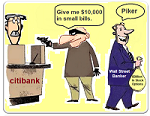
By Pam Martens and Russ Martens: April 2, 2020 ~ Yesterday CNBC reported that Citigroup is one of the banks selected by the Small Business Administration to handle billions of dollars earmarked in last week’s stimulus bill to help small businesses get back on their feet and keep their employees paid during the coronavirus crisis. Citigroup’s Citicorp subsidiary was charged with, and pleaded guilty to, a criminal felony count brought by the U.S. Department of Justice on May 20, 2015 for its role in rigging foreign currency trading. Its rap sheet for a long series of abuses to its customers and investors since 2008 is nothing short of breathtaking. (See its rap sheet at the end of this article.) During the financial crash of 2007 to 2010, Citigroup received the largest bailout in global banking history after its former top executives had walked away with hundreds of millions of dollars … Continue reading
Wall Street Had Cut 68,000 Jobs and Received Trillions in Emergency Loans Prior to COVID-19 Anywhere in the World
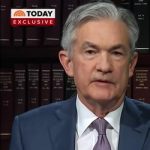
By Pam Martens and Russ Martens: April 1, 2020 ~ On March 26 Federal Reserve Chairman Jerome Powell went on the Today show to deliver one message: “There is nothing fundamentally wrong with our economy.” Recently U.S. Treasury Secretary Steve Mnuchin has appeared on the White House lawn to tell reporters that this is nothing like the last financial crisis. Fed regional bank presidents have appeared on cable news asserting that the Wall Street banks have plenty of capital and today’s economic distress is caused solely by the coronavirus. Even New York Times columnist and perpetual Wall Street cheerleader, Paul Krugman, was on CNBC this week reassuring viewers that today’s problem was not like the last financial crisis. And yet – the facts keep getting in the way of this “official” narrative. The first coronavirus COVID-19 case was discovered in China in December 2019 and didn’t become a major issue … Continue reading
The Dark Secrets in the Fed’s Last Wall Street Bailout Are Getting a Devious Makeover in Today’s Bailout

By Pam Martens and Russ Martens: March 31, 2020 ~ From December 2007 to November 10, 2011, the Federal Reserve, secretly and without the awareness of Congress, funneled $19.6 trillion in cumulative loans to bail out the trading houses on Wall Street. Just 14 global financial institutions received 83.9 percent of those loans or $16.41 trillion. (See chart above.) A number of those banks were insolvent at the time and did not, under the law, qualify for these Fed loans. Significant amounts of these loans were collateralized with junk bonds and stocks, at a time when both markets were in freefall. Under the law, the Fed is only allowed to make loans against “good” collateral. Six of the institutions receiving massive loans from the Fed were not even U.S. banks but global foreign banks that had to be saved because they were heavily interconnected to the Wall Street banks through … Continue reading
Icahn Called BlackRock “An Extremely Dangerous Company”; the Fed Has Chosen It to Manage Its Corporate Bond Bailout Programs

By Pam Martens and Russ Martens: March 30, 2020 ~ In 2015, the legendary Wall Street investor, Carl Icahn, called BlackRock “an extremely dangerous company.” (See video clip below.) Icahn was specifically talking about BlackRock’s packaging of junk bonds into Exchange Traded Funds (ETFs) and calling them “High Yield,” which the average American doesn’t understand is a junk-rated bond. The ETFs trade during market hours on the New York Stock Exchange, giving them the aura of liquidity when one needs it. Icahn said: “I used to laugh with some of these guys…I used to say, you know, the mafia has a better code of ethics than you guys. You know you’re selling this crap.” Icahn warned that “if and when there’s a real problem in the economy, there’s going to be a rush for the exits like in a movie theatre, and people want to sell those bonds, and think … Continue reading
The Tide Is Going Out and JPMorgan, Deutsche Bank and AIG Appear to Be Swimming (Read Trading) Naked
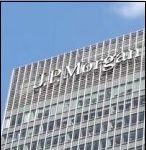
By Pam Martens and Russ Martens: March 29, 2020 ~ Warren Buffett is credited with the quote: “Only when the tide goes out do you discover who’s been swimming naked.” Friday’s closing prices among some of the heavily interconnected mega Wall Street banks and insurance companies known to be counterparties to Wall Street’s derivatives appeared to show who’s swimming naked in the realm of derivatives – naked meaning who has sold derivative protection (gone short the risk) on something that is blowing up. As the chart above shows, the S&P 500 stock index (SPX) closed with a loss of 3.37 percent while the following three stocks closed with more than double that percentage of loss: Deutsche Bank was down by 7.44 percent; JPMorgan shed 7.12 percent while AIG was off by 7.27 percent. When the Federal Reserve needs to create a hodgepodge of secretive Special Purpose Vehicles (SPVs) and run … Continue reading
Stimulus Bill: The Fed and Treasury’s Slush Fund Is Actually $4 Trillion
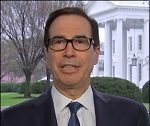
By Pam Martens and Russ Martens: March 25, 2020 ~ Senate Majority Leader Mitch McConnell and New York State Senator and Minority Leader Chuck Schumer trotted out to the Senate floor after midnight last night to announce that they had reached a deal on the government stimulus package – the text of which the American public has not seen and only snippets of which have been seen by the members of Congress. Neither the Senate nor the House of Representatives have yet to vote on the bill. Americans got their first whiff that this was going to be another massive giveaway to Wall Street banks, just as happened from 2007 to 2010, when White House economic adviser Larry Kudlow appeared at the White House briefing yesterday evening. Kudlow revealed that the stimulus plan is actually a $6 trillion package — $2 trillion to struggling Americans and $4 trillion to dispense … Continue reading
This Is the Fear Chart that the Smart Money on Wall Street Is Watching
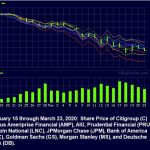
By Pam Martens and Russ Martens: March 24, 2020 ~ The chart that tells you how all of today’s economic troubles are going to end is not the bar graph of new deaths from coronavirus in Italy versus deaths in the U.S. It’s the chart that shows the number of potential deaths among the banks and insurance companies that have gorged themselves on risky derivatives and serve as counterparties to each other in a daisy chain of financial contagion. The chart above is why the Federal Reserve is throwing unprecedented sums of money in all directions on Wall Street. Because despite being a primary regulator to these massive bank holding companies, the Fed has no idea who is actually in trouble on derivative trades, other than looking at a chart like the one above. The chart above also justifies the Democrats refusing to sign off on the fiscal stimulus legislation … Continue reading
For First Time in History, Fed to Make Billions in Loans to Big and Small Businesses
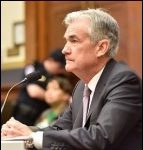
By Pam Martens and Russ Martens: March 23, 2020 ~ Without one vote by an elected official, the Federal Reserve just became a brand new national legislative body. It will, without any oversight in Congress, decide what corporations and businesses to save and which to let fail. While the corporations and small businesses will receive “billions,” Wall Street’s mega banks and trading houses will, once again, have trillions of dollars of toxic securities removed from their balance sheets, including plunging stocks through the Fed’s Primary Dealer Credit Facility. The Fed also announced that its purchases of Treasury and Mortgage-Backed Securities (MBS) will now be limitless, rather than capped at a total of $500 billion. The reason for that change is that the Fed blew through $272 billion in Treasury purchases and $68 billion in MBS purchases just last week alone, already using up $340 billion of its $500 billion allotment … Continue reading
JPMorgan Chase and Citibank Have $2.96 Trillion in Exposure to Credit Default Swaps

By Pam Martens and Russ Martens: March 22, 2020 ~ According to the most recent report from the regulator of national banks, the Office of the Comptroller of the Currency (OCC), JPMorgan Chase has exposure to $1.2 trillion in Credit Default Swaps while Citibank has exposure to $1.76 trillion for a combined total of $2.96 trillion as of September 30, 2019. According to the same report, the total exposure to Credit Default Swaps among all national banks in the U.S. is $3.7 trillion – meaning that just these two banks are responsible for 80 percent of that exposure. As of this past Friday, JPMorgan Chase had lost 39.3 percent of its common equity capital in the past five weeks while Citigroup, parent of Citibank, had lost 51.7 percent. That left JPMorgan Chase with just $256.68 billion in market cap versus Citigroup’s meager $79.86 billion. One of our readers emailed us … Continue reading
Five Mega Wall Street Bank Stocks Have Lost Average of 45 Percent in Five Weeks

By Pam Martens and Russ Martens: March 21, 2020 ~ Above is the chart that has the Federal Reserve and its Wall Street money funnel (a/k/a New York Fed) chewing on their worry beads and rapidly rolling out their alphabet soup of Wall Street bailout programs in a replay of their playbook during the 2007-2010 Wall Street collapse. While Fed and Treasury officials have been repeatedly assuring Americans that these Wall Street behemoth banks have plenty of capital, they’ve actually been bleeding their common equity capital faster than a snow cone in July. In just the past five weeks, from the close of trading on Friday, February 14 through the close of trading on Friday, March 20, five of the largest Wall Street banks have lost an average of 45 percent of their common equity capital. Adding to the embarrassment for the Federal Reserve, Citigroup, the bank it propped up … Continue reading

